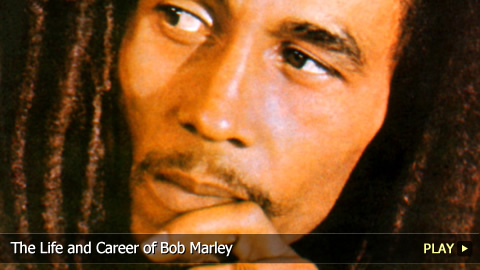The Life and Career of Bob Marley

First Recordings
Marley’s first recordings came out in 1962 under the name Bobby Martell. They received little attention, though they later appeared on the 1992 box set, Songs of Freedom.
The Wailers
Wailer, Tosh and Marley then formed the ska and rocksteady group The Wailers with a few other musicians. Working with producer Coxsone Dodd, they recorded a number of songs that became Jamaican hits and released their self-titled debut in 1965. Following the departure of several members, Marley became The Wailers’ lead singer and rhythm guitarist.
Rasta Influences
After a brief musical hiatus in which he married Rita Anderson and moved to the U.S., Marley re-united with Tosh and Wailer in Jamaica. The Wailers’ music began to incorporate the influence of the Rastafari movement, which was growing in popularity.
Working with Lee "Scratch" Perry
The trio soon began to record tracks that would become Wailers’ classics after teaming up with reggae artist Lee “Scratch” Perry and his studio band, The Upsetters. With their potent vocals and inventive rhythms, the songs also helped to shape the future of reggae music. Examples include “Soul Rebel,” from the 1970 album, Soul Rebels and “Duppy Conqueror” from the 1971 record, Soul Revolution.
American Attention
The Wailers’ popularity continued to grow in the Caribbean, though they were still relatively unknown internationally. Things began to change when they released their major label debut, 1973’s Catch a Fire on Island Records. The album charted in the U.S. and its dance rhythms, along with Marley’s militant lyrics, received positive reviews.
International Popularity
Next, the Wailers came out with Burnin’. The roots reggae record raised Marley’s global profile even more, especially due to several standout tracks. These included “Get Up, Stand Up” and “I Shot the Sheriff,” which singer Eric Clapton turned into a hit with his 1974 cover.
Bob Marley & The Wailers
After a few tour dates outside of Jamaica, the band returned home. Tosh and Wailer left the group and Marley created a new line-up under the name Bob Marley & The Wailers. They released Natty Dread in 1974. The socio-politically charged album embraced Marley’s spiritual side and contained one of Marley’s most well-known songs, “No Woman, No Cry.”
American Breakthrough and Assassination Attempt
Up next was their American breakthrough record, 1976’s Rastaman Vibration. The synthesizer-heavy effort was notable for the songs, “War,” and “Roots, Rock, Reggae.” At the end of that year, Marley was the victim of an assassination attempt. The shooting was suspected of being politically motivated, and it prompted the artist to leave for England shortly thereafter.
"Exodus" and Super-stardom
Exodus came out in 1977. The album’s success turned Marley into an international superstar and has since been hailed as one of the best albums in history. It spawned the international hits, “Waiting in Vain,” and “One Love/People Get Ready.”
Love and Drugs
Next was 1977’s Kaya, a more relaxed effort that centered on love and marijuana. It contained the popular songs, “Sun is Shining” and “Is This Love.” That year, Marley returned to Jamaica to play the One Love Peace concert.
"Survival"
Bob Marley & The Wailers came out with Survival in 1979. The album spoke of political issues, especially pertaining to Marley’s support of African struggles. Notable tracks included “Africa Unite” and “Zimbabwe.”
Final Studio Album
Marley’s final studio album was 1980’s Uprising. It was an extremely religious effort, and this was particularly evident on “Redemption Song.” This track saw Marley ponder his mortality because he had recently been diagnosed with skin cancer that had spread throughout his body.
Death
Marley’s deteriorating health led to the cancellation of the subsequent world tour. He started his way back to Jamaica but did not complete the trip. He died in a Florida hospital on May 11th, 1981.
Posthumous Releases
Several posthumous releases followed. 1983’s Confrontation featured previously unreleased material, including the song, “Buffalo Soldier.” And 1984’s Legend became the best-selling reggae album in history, and contained many of Marley’s biggest hits, including “Stir it Up” and “Jamming.”
Legacy
Bringing Jamaican music and Rasta to a global audience with his intense live performances and politically-charged lyrics, Bob Marley is one of the most respected reggae artists of all-time.
